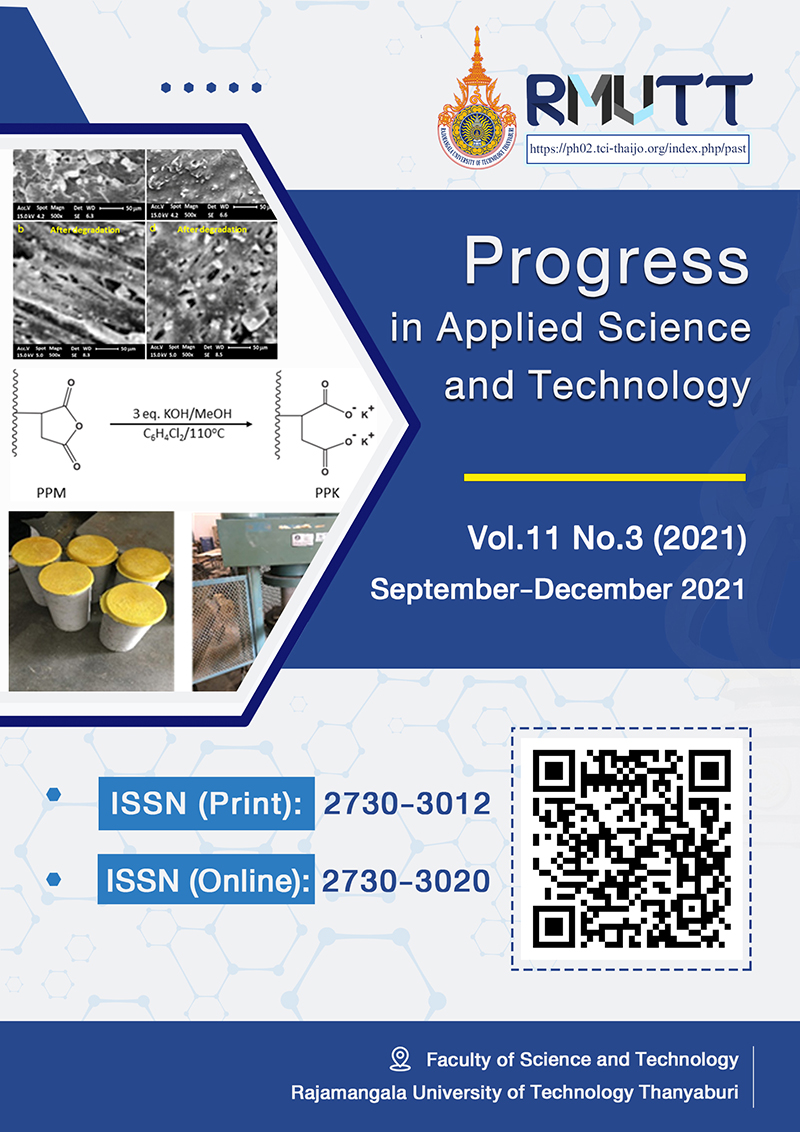Effect of Osmotically Process on Bastard Oleaster (Elaeagnus latifolia L.) Fruit Bar
Main Article Content
Abstract
This presented study aims to develop a fruit bar from bastard oleaster fruit. The osmotically dehydrated process was studied by soaking a whole fruit in sucrose syrup at the concentration of 20, 30 and 40 °Brix and adjusting pH at 2.5 and 2.8 by citric acid. The results indicated that the optimal process of bastard oleaster fruit bar was the fruit immersion in 40 °Brix sucrose syrup and controlling pH of syrup at 2.8 for 20-24 h. Then, the infused fruits were dried at 50-55 °C for 20-24 h. Thereafter, the osmotically dehydrated fruit were mixed with fructose syrup in the ratio of 5:1 weight by weight (w/w), formed into a rectangular shape, and dried at 50-55 °C for 12 h. Sensory evaluation showed that the finished product had the high acceptability scores in terms of appearance, color, taste, flavor, texture, and overall liking corresponding to like slightly to like moderately. It contained total soluble solid of 74.40 °Brix, 1.13 % total acidity, 1.78 mg ascorbic acid/100 g, and 1.27 mg gallic acid equivalent/g. This product also exhibited a high antioxidant activity as DPPH assay. Therefore, the bastard oleaster fruit bar can be used as an alternative health products for consumption.
Article Details

This work is licensed under a Creative Commons Attribution-NonCommercial-NoDerivatives 4.0 International License.
References
Constantin OE, Istrati DI. Functional Properties of Snack Bars. 2018 [updated 2018 Nov 5; cited 2020 Jan 20]. Available from http://dx.doi.org/ 10.5772/intechopen.81020
Diamante ML, Bai X, Busch J. Fruit leathers: method of preparation and effect of different conditions on qualities. Int J Food Sci. 2014;3: 1-12.
Gibson EL, Wardle J. Effect of contingent hunger state on development of appetite for a novel fruit snack. Appetite. 2001;37: 1-11.
Ramalingam C, Prenitha IM, Rai S, Gupta S. Development of tropical fruit bars and assessment of its shelf life. J. Exp. Sci. 2010;1(7): 26-32.
Food Intelligence Center Thailand. Sweet bicuits, snack bar, and fruit snacks in Thailand. 2020 [updated 2020 Oct; cited 2021 Jan 20]. Available from http://fic.nfi.or.th/MarketOver viewDomesticDetail.php?id=309#. In Thai.
Patel S. Plant genus Elaeagnus: underutilized lycopene and linoleic acid reserve with perma culture potential. Fruits. 2015;70(4): 191-199.
Panja S, Chaudhuri D, Ghate NB, Minh HL. In vitro assessment of phytochemicals, antioxidant and DNA protective potential of wild edible fruit of Elaeagnus latifolia Linn. Fruits. 2014;69(4): 303-314.
Seal T. Evaluation of nutritional potential of wild edible plants traditionally used by the Tribal prople of Meghalaya state in India. Am. J. Plant Nutr. Fert. Technol. 2012;2(1): 19-26.
Yingthongchai P, Sirikhum P. Genetic diversity of Elaeagnus litolia Linn.: morphological and physico-chemical characters of fruits. Agricultural Sci. J. 2008;39(3(Suppl.)): 118-121. In Thai.
Singh A, Sonkar C, Shingh S. Studies on development of process and product of plum fruit leather. Int J Food Sci Nutr. 2019;4(5): 74-79.
AOAC, Association of Analytical Communities. Official Methods of Analysis. 17th ed: Gaithersberg: MD: USA; 2000.
Parimita Er, Puneet Arora Er. Development of fruit bar by using apple and banana pulp supplemented with omega-3 fatty acid. Int. J of Engineering Studies and Technical Approach. 2015;1(2): 27-35.
Brand-Williams W, Cuvelier ME, Berset C. Use of free radical method to evaluate antioxidant activity. LWT-Food Sci Technol. 1995;28: 25-30.
Nowak D, Gośliński M, Wojtowicz E. Comparative analysis of the antioxidant capacity of selected fruit juices and nectars: chokeberry juice as a rich source of polyphenols. Int J Food. 2016;19: 1317-1324.
Park K, Bin A, Brod F. Drying of pear d’Anjou with and without osmotic dehydration. J Food Eng. 2002;56: 97-103.
Shakoor A, Ayub M, Wahab S, Khan M, Khan A, Rahman Z. Effect of different levels of sucrose-glucose mixture on overall quality of guava bar. J. Food Proc. Tech. 2015;6(8): 469.
Srivastava A, Kohli D, Vishnoi S, Kumar S, Badola R. Quality evaluation of prepared guava-orange fruit bar. Int. J. Chem. Stud. 2019;7(4): 1574-1581.
Samborska K, Eliasson L, Marzec A, Kowalska J, Piotrowski D, Lenart A, et al. The effect of adding berry fruit juice concentrates and by-product extract to sugar solution on osmotic dehydration and sensory properties of apples. J. Food Sci. Tech. 2019;56(4): 1927-1938.
Pawase P, More D, Satwadhar P. Effect of addition of pectin on textural and sensorial quality characteristics of fig mango bar. J. Pharmacogn. Phytochem. 2017;6(5): 469-471.
Gharsallaoui A, Rogé B, Génotelle J, Mathlouthi M. Relationships between hydration number, water activity and density of aqueous sugar solutions. Food Chem. 2008;106(4): 1443-1453.
Labuza TP, Tannunbaum SR, Karel M. Water content and stability of low moisture and intermediate moisture foods. Food Technol. 1970;24: 35-42.
Kumar V, Said PP. Physico-chemical characterization Elaeagnus latifolia from Sikkim Himalayas. Int. J. Pure Appl. Biosci. 2018;6(5): 361-366.
Hussain S, Aslam A, Ali M, Jussain N. Some physicochemical and nutritional properties of Elaeagnus angustifolia L. fruit grown in Gilgit Baltistan. Int J Food Sci Nutr. 2018;3(1): 112-115.
TISI, Thai Industrial Standards Institute. Thailand Industrial Standard (TIS) of Dried Fruit: TIS 919-2532: Bangkok: Thailand; 1989.





